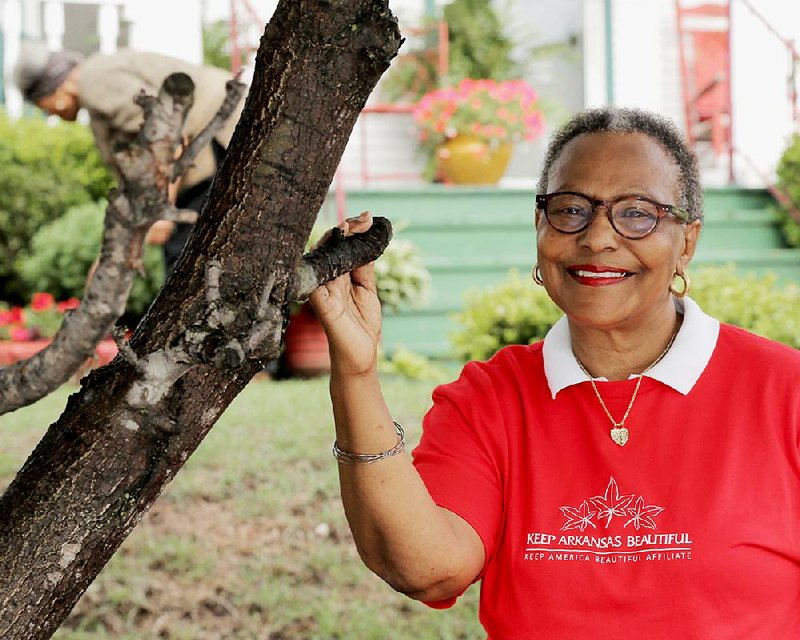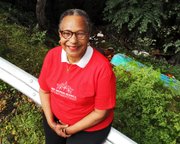At the end of Martin Luther King Jr. Drive, where it becomes 36th Street, there's a sharp turn and a ravine to the right. It's difficult to see, but over the guardrail it's a dump. There are mattresses and yard furniture and a long tangle of radial tires that kind of resembles costume jewelry for a giant.
"Now, those tires, you see? That had to come from a business," says Minnie Hatchett, the face of the South End Neighborhood cleanup.
For 13 years Hatchett and a squad of rangers -- many retirees or folks of retirement age, some of them in their 80s -- have picked a Saturday in the spring to pick up an area that extends roughly from Interstate 30 on the east, Roosevelt Road on the north, the railroad tracks on the south and Barton Coliseum on the west.
This neighborhood cleanup effort is one of the more vibrant examples of Keep Arkansas Beautiful, the year-round effort to curb litter and trash and generally beautify the capital city, its neighborhoods and the entire state. For the nonprofit's 25th anniversary celebration -- scheduled for May 7 if weather permitted -- Hatchett was one of 25 celebrated "lodestars."
Returning to the tires, the moonlight dumping, "These are the types of things we face most in our neighborhood," she says.
For Hatchett, the problem is on the ground -- not foreclosures or flight, not lapses in city services or another thing. It's trash piled on curbs and debris blowing around, fallen trees and branches, front yards that are more "yards" than "fronts." Eyesores.
Hatchett is an ambassador for the South End and believes this spot has appeal if it could just turn a corner. Nearby Crump Park is an inviting area with playground equipment and nice turf, a ball field in back and basketball courts (in a better state than some popular ones around) across the street.
A sparrow's flight from here, along a single block of Spring Street called "Short Spring Street," is 80-year-old Delores Collier. Hatchett's proud to count her among the ranks.
"What happens, the owners die," Collier says, by way of explaining the fates of some of the worst lots. "The owners die, and renters arrive. You see that trash out there" -- she waves at a spot not evident to Hatchett or the reporter -- "that young man died, and now, renters, but renters don't want to clean up, and that's our problem. I was always taught, you can be poor but you can be clean."
Hatchett nods in agreement.
"My mama always said, it doesn't matter if you dropped it or not, pick it up," she said.
This is something Hatchett repeats in one variation or another a lot. It's a mantra.
Around the way is Everdean Daniels, 77. She's a tall, slim, almost regal-looking woman pruning the tops of box elders in a leopard-print headscarf tied in front. She's another of Hatchett's "faithful." Her house in the 2700 block of Gaines is a vision of effort and self-respect. Her roses are gorgeous.
"It's not just one day," she says of the Saturday cleanup.
Of Hatchett, she says, "She wouldn't ever forget about us and how hard we worked" for her and for themselves during these cleanups.
The house across the street appears uninhabited, half boarded up, and Hatchett says it was nearly destroyed by fire. Does Daniels despair at her Southern Living-level attention to detail, just to stand on her porch and face something so forsaken?
That's completely wrong, she says. The owner of that house is working on it -- "working from the inside out." In fact, there's some evidence of it, brand new second-story windows. No, "we have hope for that house," and hope for the neighborhood.
Hatchett, 72, is still working. She's associate director of a North Little Rock satellite of the University of Arkansas at Pine Bluff and an adjunct professor at Arkansas Baptist College. She's a graduate of Pulaski County Training School in North Little Rock (now the site of Harris Elementary School), then Philander Smith College, then Texas Southern University in Houston. She earned her doctorate in higher education administration at the University of Arkansas at Little Rock in 2000. Each Sunday she attends Mass at St. Augustine Catholic Church in North Little Rock.
By her own reckoning, she's just very motivated, and fortunate, to do this work.
"I'm so blessed. I don't take any medications. I have no pains, and I'm almost 73 and able to work a job! I'm blessed, and I don't mind sharing," she says, turning again onto Martin Luther King Jr. Drive. "So this is Martin Luther King, and you see how clean it is here? That's Mrs. Sabbs' [doing]. She's out sweeping every day."
She pulls into the drive, gets out, pounds on the door. "Mrs. Sabbs!" No one's home.
Isn't this a wider issue, one of jobs and race and income? She doesn't think so. It's an age issue. Her neighborhood is overwhelmingly old people. And poor -- most are living on maybe $1,000 a month. She once bought a window air conditioner for a woman trying to sweat out an Arkansas summer. "I want to be a person who's known to be a giver," she says -- especially if it means keeping a good homeowner home owning.
It would go a long way to attract younger homeowners, too, if the South End could get historical neighborhood status, with all the grant possibilities and tax breaks they allot.
"I think historical [status] would be a big surge, because they're getting ready for that research technology center. [That means] people coming in from other countries. Perhaps they'd want to live here. We are seeing some diversity in our area, people -- white people -- transitioning back."
High Profile on 05/08/2016

